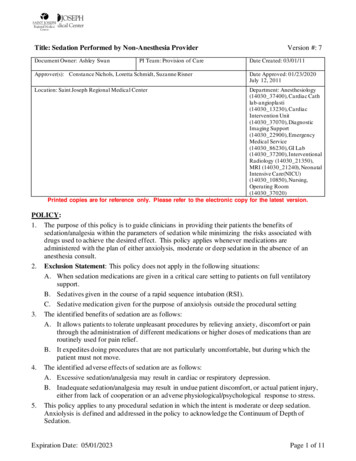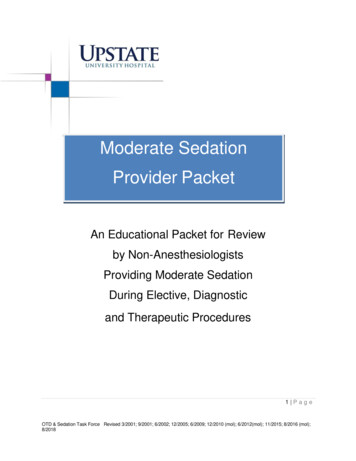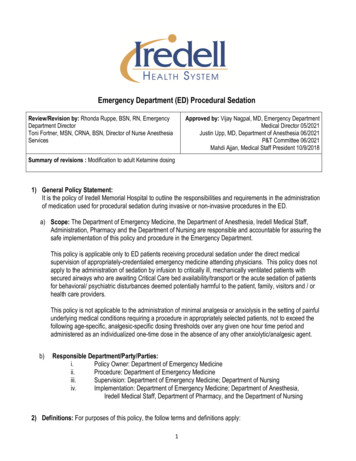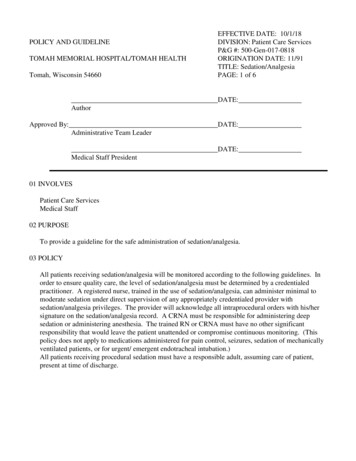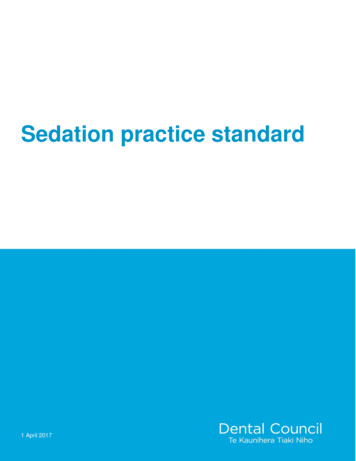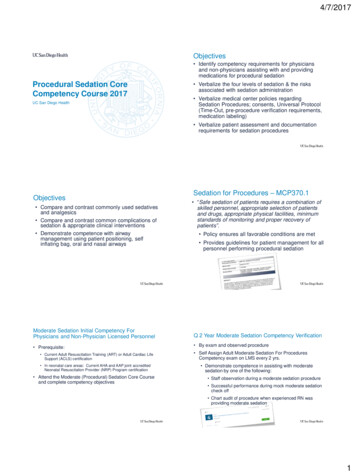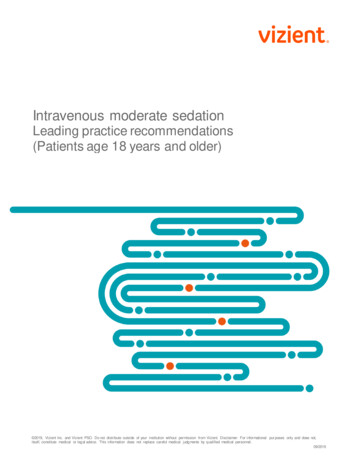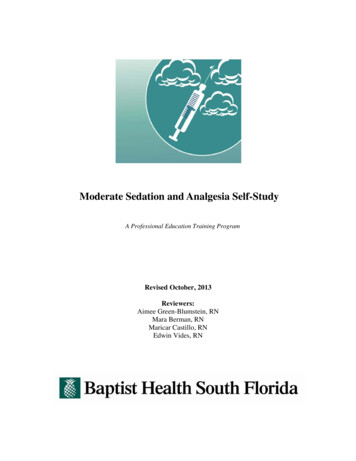
Transcription
Moderate Sedation and Analgesia Self-StudyA Professional Education Training ProgramRevised October, 2013Reviewers:Aimee Green-Blumstein, RNMara Berman, RNMaricar Castillo, RNEdwin Vides, RN
Moderate Sedation and Analgesia Self-StudyOctober 20131Moderate Sedation and AnalgesiaSelf-StudyLearning ObjectivesUpon completion of this course, the participant will be able to:1. Describe the continuum of sedation and differentiate moderate sedationfrom deep sedation.2. Discuss the pre-, peri-, and post- monitoring of patients receivingmoderate sedation.3. Review the pharmacological implications for sedation and analgesia in themonitoring of patients receiving moderate sedation.4. Describe proper airway management of the patient receiving moderatesedation.5. Identify complications and emergency measures associated withcomplications of moderate sedation.
Moderate Sedation and Analgesia Self-StudyOctober 20132MODERATE SEDATION AND ANALGESIADefinitionsTHE CONTINUUM OF SEDATIONPractitioners intending to produce a given level of sedation should be ableto rescue patients whose level of sedation becomes deeper than initiallyintended.– Individuals administering Moderate Sedation/Analgesia ("ModerateSedation") should be able to rescue patients who enter a state ofDeep Sedation/Analgesia.– Those administering Deep Sedation/Analgesia should be able torescue patients who enter a state of general anesthesia.DEFINITIONS OF THE FOUR LEVELS OF SEDATION ANDANESTHESIAThe Continuum of SedationNo SedationMinimal SedationModerateSedationDeep SedationAnesthesiaBecause sedation is a continuum, it is not always possible topredict how an individual patient will respond.1. Minimal sedation(anxiolysis) is a druginduced state duringwhich patientsrespond normally toverbal commands.Although cognitivefunction andcoordination may beimpaired, ventilatoryand cardiovascularfunctions areunaffected.2. Moderate sedation / analgesia is a drug-induced depression ofconsciousness during which patients respond purposefully to verbal commands(Note: Reflex withdrawal from painful stimulus is not considered a purposefulresponse) either alone or accompanied by light tactile stimulation. Nointerventions are required to maintain a patent airway and spontaneousventilation is adequate. Cardiovascular function is usually maintained.
Moderate Sedation and Analgesia Self-StudyOctober 201333. Deep sedation is a drug-induced depression of consciousness during whichpatients cannot be easily aroused but respond purposefully following repeated orpainful stimulation. The ability to independently maintain ventilatory function isoften impaired. Patients may require assistance in maintaining a patent airwayand spontaneous ventilation may be inadequate. Cardiovascular function isusually maintained.4. Anesthesia consistsof general anesthesiaand spinal or majorregional anesthesia. Itdoes not include localanesthesia. General Post- operative Pain Pre-Medication:anesthesia is a drugManagement:-Defined as a singleinduced loss of- Given for post-opconsciousness duringdose prior to awhich patients are notpain, including PCAmedication.arousable, even by- Medication is not-Medication is notpainful stimulation. TheTITRATED to effectTITRATED toability to independentlyas in moderatemaintain ventilatoryeffect as insedationfunction is often impaired.moderatePatients often requiresedationassistance in maintaininga patent airway, andpositive pressure ventilation may be required because of depressed spontaneousventilation or drug - induced depression of neuromuscular function.Cardiovascular function may be impaired.What Moderate Sedation isnot:Goals of ModerateSedationModerate Sedation shouldresult in: Alteration of LOC and mood. Maintenance of consciousness andcooperation. Elevation of pain threshold. Minimal variation of vital signs. Rapid degree of ambulation. Safe and prompt recovery. A patient that is relaxed, cooperativewith:– Purposeful responses to verbalcommunication and instruction.– Purposeful response to tactile stimulation– Easy and prompt arousal from sleep.
Moderate Sedation and Analgesia Self-StudyOctober 20134PERSONNEL QUALIFICATIONSIncluded in the qualifications of individuals providing moderate sedation iscompetency-based education, training, and experience in:1. Evaluating patientsprior to performingmoderate sedationand analgesia and2. Performing themoderate sedation toinclude methods andtechniques requiredto rescue thosepatients whounavoidably slip intoa deeper-thandesired level ofsedation oranalgesia.Training andCredentialing Airway managementtraining to include: Oropharyngealairways Positive pressureventilation devices,such as ambu bag Cardiac Monitoring ACLS Pharmacologytraining to include: Dosages Routes, Side Effects Emergencymanagement,includingantagonistsPhysicians and nurses who have appropriate qualifications are permitted toadminister moderate sedation/analgesia and must be qualified to rescue patientsfrom deep sedation. They must be competent to manage a compromised airwayand to provide adequate oxygenation and ventilation.Staff Qualifications Physicians must be granted clinical privilegesfor moderate sedation/analgesia through thehospital’s medical staff office. RN’s must be deemed competent to monitorand manage the care of patients receivingmoderate sedation through the hospital’scompetency assessment program.Anesthesia professionalare permitted toadminister all types/levelsof anesthesia.Anesthesia professionalsare qualified to rescuepatients from generalanesthesia. They arecompetent to manage anunstable cardiovascularsystem as well as acompromised airway andinadequate oxygenationand ventilation.
Moderate Sedation and Analgesia Self-StudyOctober 20135The goals of moderate sedation are to maintain adequate sedation with minimalrisk, relieve anxiety and produce amnesia and provide relief from pain and othernoxious stimuli. There must be a registered nurse present who has beendeemed competent through the hospital’s competency assessment andvalidation process to monitor and manage the care of sedated patient.Staff Qualifications Physicians must be granted clinical privilegesfor moderate sedation/analgesia through thehospital’s medical staff office. RN’s must be deemed competent to monitorand manage the care of patients receivingmoderate sedation through the hospital’scompetency assessment program.EQUIPMENT AND SUPPLIESEach designated area where sedation is administered must have emergencyresuscitative equipment immediately available, which is equivalent to that used inother areas of the hospital, and which is checked and maintained on a scheduledbasis. All emergency equipment must be able to accommodate patients of anysize or age undergoing procedures in that area. Appropriate equipment forpatient care and resuscitation will include: Emergency cartEmergency drugsDefibrillatorEKG monitorBlood pressure monitorStethoscopePulse oximeterETCO2 (Capnography) ifavailable Appropriate airwaysSuction device/suction cathetersOxygen sourceNasal O2 cannulas / O2 masksIntubation equipmentPositive pressure oxygen deliverydevice ( bag-valve-mask) IV supplies
Moderate Sedation and Analgesia Self-StudyOctober 20136PRE PROCEDURE PATIENT ASSESSMENTPatient selectionfor moderatesedation is basedon many factors.Patients whowould not be idealcandidates Verifying that pre-assessment findingsinclude patientsare documented and informed consentwho are morbidlyis obtained and signed by patient.obese, have sleepapnea, significant Ensuring that NPO status of patient iscardiac and orconfirmed.pulmonary Monitoring patient before, during,anddisease,significantafter administration of moderateimpairment ofsedation.kidney or liverfunction, aphysical deformitythat couldcompromise airway management, are mentally challenged, extreme of age orpatients in whom moderate sedation alone is not expected to provide adequateconditions. An anesthesiologist should be consulted for the management ofthese patients.RN ResponsibilitiesPre procedure patient assessment should include evaluation of the following Relevant aspects of the patient’s medical history including abnormalities ofthe major organ systems, previous adverse experiences with sedation /anesthesia, current medications, allergies, weight, communication level, andpain assessment. ASA Physical Risk Classification. This assessment is performed by ananesthesiologist &/or a CRNA.
Moderate Sedation and Analgesia Self-StudyOctober 20137ASA Classification SystemASA ClassificationASA IMedical DescriptionNo known systemicdiseaseCommentMay have moderatesedation withoutother consideration.ExampleHealthy patientwithout evidence ofsystemic diseasePatient who smokeswith well controlledhypertensionASA IIMild or wellcontrolled systemicdiseaseASA IIIMultiple or moderatecontrolled systemicdiseaseConsider medicalconsultation.Patient withdiabetes and fairlystable anginaASA IVPoorly controlledsystemic disease.Considerinvolvement ofAnesthesia for MACASA VMoribund patientPatient withdiabetes, angina andCHF with dyspneaon exertion andchest pain orUnstable patient notexpected to survivewithout interventionASA VIDeclared Brain DeadOrgan removal fordonation Focused physical examination including auscultation of the heart and lungsand evaluation of the airway. Pre procedure laboratory testing should be guided by the patient’s underlyingmedical condition and the likelihood that the results would affect themanagement of the sedation/analgesia. Adequate Hgb is needed foroxygenation. Vital signs to include blood pressure (BP), pulse (P), respirations (RR), andoxygen saturation (O2 sat). Level of conscious (LOC). NPO status.
Moderate Sedation and Analgesia Self-StudyOctober 20138NPO GUIDELINESNPO Guidelines Sedation and analgesics tend to impairairway reflexes in proportion to thedegree of sedation achieved. Aspiration is the most common cause ofdeath associated with IV moderatesedation (1 – 20%). Mortality is significant with long hospitalstays.NPO guidelines specify the time-frames for patients to be restricted fromconsuming fluids or solids by the gastrointestinal route. This includesnasogastric and gastrostomy feedings. These are minimum NPOrecommendations that apply to healthy (ASA 1 or 2) patients. Theserecommendations are not intended for women in labor.NPO Guidelines Gastric emptying can be influenced bymany factors, including anxiety, pain,pregnancy or mechanical obstruction. The suggested times do not guaranteegastric emptying. As a rule for adults, for solids and nonclear liquids, the patient should fast for6 to 8 hours before the procedure.
Moderate Sedation and Analgesia Self-StudyOctober 20139Universal NPO GuidelinesIngested MaterialMinimum Fasting Period1Clear Liquids22 HoursBreast Milk4 HoursInfant Formula6 HoursNon-Human Milk36 HoursLight Meal46 HoursMeal58 Hours or MoreRefer to Procedure No: SMH-IP 23171Fasting period applies to all ages2Examples of clear liquids include water, fruit juices without pulp, carbonatedbeverages, clear tea and black coffee3Since non-human milk is similar to solids in gastric emptying time, the amountingested must be considered when determining an appropriate fasting period.45A light meal typically consists of toast and a clear liquid.A meal that includes fried or fatty foods or meat might prolong gastric emptyingtime, both the amount of food and the type of food ingested must be consideredwhen determine and appropriate fasting period.
Moderate Sedation and Analgesia Self-StudyOctober 201310AIRWAY ASSESSMENTThe administration of sedative and analgesic medications may interfere with thepatent’s ability to maintain a patent airway; therefore pre procedure evaluation ofthe lungs and airway is essential. The lungs should be assessed for anyabnormal breath sounds such as rales or wheezing. The airway may beassessed by the physician using the Mallampati technique, which is used byanesthesia providers to determine possible intubation difficulty, information ofvalue to the physician.The Mallampati technique categorized the airway into one of four classes:Class I: Visualization of the faucial pillars, soft palate and uvula.Class II: Visualization of the faucial pillars and soft palate. The uvula ismarked by the tongue.Class III: Visualization of only the soft palate.Class IV: Soft palate not seen.If possible, the patient should be assessed in a sitting position. The patient isdirected to open the mouth as wide as possible and protrude the tongue,exposing the faucial pillars and uvula at the tongue base. If the classificationexceeds Class I, the physician should proceed with the appropriate plan ofaction. This simple precautionary measure alerts the physician to anticipatedifficulty in the event of respiratory depression requiring intubation. For patientswith a Class II, III and IV airway, a consultation with an anesthesia provider isrecommended.
Moderate Sedation and Analgesia Self-StudyOctober 201311INFORMED CONSENTThe patient must be informed about the risks, benefits and alternatives tosedation as a component of the planned procedure. There must bedocumentation in the medical record of informed consent (Universal Protocol)and the plan of sedation prior to the procedure.Here is a general list of risks and complications that could be associated with asedative procedure:Relatively common and shortlivedUncommon and short-lived Nausea and vomiting Prolonged sleepinessHeadacheExcitability and agitationDizzinessLow blood pressureNightmaresUncommon, but may last a short time Sore lumpy vein (if medication given intravenously)RareExtremely Rare Damage or failure of the heart,liver, stomach, kidneys and orbrain Cardiopulmonary arrest DeathAllergic reactionDiminished respiratory effortInhalation of stomach contentsPneumoniaMONITORINGAll patients receivingmoderate sedation mustbe continuouslyobserved andphysiologically monitoredby a designated qualifiednurse throughout thesedation period.Assessment data, airwaypatency, respiratory rate,blood pressure andappropriate LOC andresponsiveness (as perRN Responsibilities THE RN MONITORING THE PATIENTSHOULD NOT BE ENGAGED IN ANYOTHER ACTIVITY DURING THEPERIOD OF MODERATE SEDATION.
Moderate Sedation and Analgesia Self-StudyOctober 201336standardized tool) must be documented at least every 15 minutes or morefrequently as indicated by the patient’s condition. The sedation period includedthe period of time during the administration of sedation until the patient hasreturned to pre sedation status with regard to airway, breathing, circulation, andlevel of consciousness. The patients must be reevaluated immediately prior tothe initiation of moderate sedation.USING CAPNOGRAPHY TO MONITOR VENTILATIONEnd-tidal CO2 is the amount of carbon dioxide in air at the end ofexhalation. The measurement of exhaled CO2 overtime is known ascapnography with a waveform called a capnogram. During a procedure wheremoderate sedation is administered end-tidal CO2 monitoring can help detectrespiratory depression during and after the procedure. End tidal Co2 monitoringcan be done through a special nasal cannula. It is important to monitor thepatient’s baseline CO2 prior to sedation. Monitoring the end tidal CO2 can helpdetect respiratory depression during and after the procedure is complete, beforethe patient returns to baseline level of consciousness.Carbon dioxide (CO2) is the most significant factor in monitoring ventilation.Capnography measures the CO2 in every breath to monitor air exchange in thepatient’s alveoli. Measuring herCO2 levels during procedural sedation can detectproblems in her lungs or airway and offers earlier warning of hypoventilation,respiratory depression, hypermetabolism, and hypoperfusion than monitoringSpO2 alone. Capnography measures CO2 with infrared technology and givesgraphic and digital numeric displays for end-tidal CO2 ( ETCO2) and SpO2.ETCO2 Normal range between 35-40 mmHg
Moderate Sedation and Analgesia Self-StudyOctober 201337DOCUMENTATIONCareful observation of the patient is important and must include continuousassessment of the patient’s level of consciousness, oxygenation and ability tomaintain protective reflexes. Changes in the patient’s condition will determine ifthe documentation interval frequency could be increased. Documentation in themedical record for sedative procedures should include at least the following: Informed consent, patient medical history, assessment data and evidence ofappropriate monitoring Medications administered, patient’s response, any adverse reactions, andtreatment of complications Recovery and discharge data Discharge instructions for outpatients and release to a responsible adultAny significant adverse occurrence related to or occurring during amoderate sedation procedure must be reported to Risk Management bycompleting an incident report indicating the event occurred during amoderate sedation procedure.Monitoring and Documentation Times: time patientwas assessed priorto procedure, wheninitiated, whenended, and whenmedications given. LOC Adverse Reactions Ramsey scaleapplies to intraproceduremonitoring. VS (HR, BP, O2 Sat,EKG, at a minimumevery 15 minutesduring and at end ofprocedure. Continuousmonitoring of HRand O2 Sat,documented every15 minutes untilpatient is back topresedationbaseline
Moderate Sedation and Analgesia Self-StudyOctober 201338Ramsay ScaleScore 1: Anxious, agitated, and restlessScore 2: Cooperative, oriented, tranquilScore 3: Responsive to commands onlyScore 4: Asleep but brisk response to light glabellar tapScore 5: Asleep, sluggish response to light glabellar tapScore 6: No response to light glabellar tapRECOVERY AND DISCHARGEAn objective scoring system will be used to asses the patient’s recovery fromsedative effects and his or her eligibility for discharge from the procedure area orhospital. The Aldrete Post Anesthesia Scoring System (PARS) or the ModifiedPost Anesthesia Discharge Scoring System (MPADS) should be used to assessthe patient for adequate recovery. A score of eight (8) or greater (PARS) andten (10) for MPADS must be achieved to be eligible for discharge from unitwhere procedure and recovery is being performed.Post Anesthesia Recovery ScoreActivityRespirationCirculationNeurologicalO2 Sat0 unable to lift head or move extremities1 moves two extremities voluntarily or on command and can lifthead2 able t move four extremities voluntarily or on command. Can lifthead0 apneic. Condition necessitates ventilator assisted respirations.1 labored or limited respirations. May have mechanical airway2 can take a deep breath and cough well. Has normal respiratoryrate and depth.0 has abnormally high or low BP ( 50% pre sedation level)1 BP 20-50% of pre sedation level2 stable BP and pulse. BP 20% of pre sedation level0 not responding or responding to painful stimuli1 responds to verbal stimuli but drifts to sleep easily2 awake, alert, oriented to time, place and person0 O2 saturation 90% with O2 supplement1 needs O2 inhalation to maintain O2 saturation 90% or 95%2 able to maintain pre procedure O2 saturation on room air or 95% on O2Total Recovery ScorePARScore
Moderate Sedation and Analgesia Self-StudyOctober 2013Vital SignsPainNausea &Vomiting39Modified Post Anesthesia Discharge Score (MPADS)( to be used for outpatients discharged from facility)0 within 40% or of pre sedation levels1 within 20% - 40 %2 within 20 %0 severe ( 8-10)1 moderate (4 -7 )2 minimal / none (0-3)0 severe1 moderate2 minimal / noneSurgicalBleeding0 severe1 moderate2 minimal/ noneAmbulation0 none / dizziness1 with assistance2 steady gait / no dizziness ( age appropriate)Total Discharge ScoreMPADScoreDischarge CriteriaThe following criteria should be used to assess the patient’s readiness fordischarge from the hospital. A physician is responsible for the discharge of thepatient unless the patient meets specific discharge criteria that have beenapproved by the medical staff. Supportive documentation in the medical recordshould clearly reflect: The patient’s cardiovascular function and airway patency are satisfactory andstable. A score of eight (8) or greater (PARS) and ten (10) for MPADS must beachieved to be eligible for discharge. The patient is awake and protective reflexes are intact. The patient can walk and talk (age or pre-condition appropriate). The state of hydration is adequate. The patient is accompanied by a responsible adult. For a very young child or handicapped person, incapable of the usualresponses, the pre sedation level of responsiveness should be achieved.Patients who are being discharged from the hospital following the proceduremust be given discharge instructions that include at least the following Anticipated or potential behavioral changesLimitations of activities or precautionsAppropriate dietary precautions, if anySpecific procedure-related instructions when indicatedA 24 hour telephone contact numberFor outpatients: discharge instructions provided and released to aresponsible adult.
Moderate Sedation and Analgesia Self-StudyOctober 201340PATIENT EDUCATIONPatients undergoing IV moderate sedation must not operate machinery or amotor vehicle for 24 hours or until the physician deems appropriate.Written discharge instructions are provided to the patient and family member.The patient/family is asked to verbalize their understanding of the instructionsand sign for instructions.It is important the following precautions be taken by the patient (or parent): The outpatient should not be left unattended. An adult should be with thepatient for the remainder of the day. Adults should not drive or operate machinery, drink alcoholic beverages, ormake any important decisions that day. Children may still be sleepy and nap longer than usual. The patient may resume their regular diet but it is recommended that thepatient start slowly, progressing from water and bland liquids to jello and brothto prevent nausea and vomiting. The patient may resume their medications unless otherwise directed.
Moderate Sedation and Analgesia Self-StudyOctober 201341MEDICATIONS USED INMODERATE SEDATION BENZODIAZEPINESBenzodiazepines are a class of drugs very familiar to most nurses. These drugsare utilized on a daily basis for a number of reasons. The actions are predictableand patients’ needs are met. The major side effect of these drugs is upon therespiratory system of the patient (Respiratory depression is a side effect;sedation is the expected effect.) The patient can develop a depressed ventilatoryresponse to increasing carbon dioxide levels with subsequent falling levels ofarterial oxygenation. Each 0.1 mg per kilogram of midazolam is said to reducethe body’s response to rising carbon dioxide levels by 50%. In addition, there is arise in pulmonary airway resistance. As the patient’s level of consciousnessdecreases, the risk of respiratory insufficiency increases greatly. The patient’scompensatory responses are blunted, thus carbon dioxide levels will continue torise and oxygen levels will continue to fall unless additional therapeutic measuresare undertaken. It is imperative that the nurse administering these drugs beaware of this risk and continuously monitor the patient’s respiratory effort andoxygen hy,Adults 60IV: 2.5 mg in increments, (not to exceed5 mg per single dose over 60 seconds).(Individual response is variable.)Onset: 30 seconds to 2minutes (may take upto 5 min) Duration: 60 – 180mins (may last up to 4hours); sedative effectsusually last for 3 hoursDo not dilute with saline or H20Do not mix with other drugsReduce dose of narcotic by a thirdwhen used with diazepam; reducediazepam dose by 30-50% inelderly.IV: 0.5 to 2.5 mg over at least 2minutes. Repeat in 2 minutes, if needed,in small increments of initial dose overat least 2 minutes to achieve desiredeffect. Overall dose 2.5-5 mg.Elderly: Initial dose 0.5 mg slow IV,give no more than 1.5 mg over 1 minuteperiod, waiting another 2 minutes toevaluate sedative effect. Total dose 3.5mg is rarely necessary.Titrate with small increments allowing 2minutes after each dose to evaluateeffect. Once sedation is achieved,additional doses should be 25% of thedose required to produce the sedativeendpoint; for maintenance, use 0.25 mgto 1 mg.Total dose: usually 5 mgReduce dose by 30% if patient waspremedicated with a narcotic or otherCNS depressant.Administer into a large vein;monitor airway, 02 sats and HR.Duration: 2 to 6 hours.Titrate to slurring of speech.Contraindicated in untreatednarrow-angle glaucoma; irritating toveins-may cause phlebitis,thrombosis, and local inflammation.Avoid in pregnant women, esp.during first trimester.Titrate to slurred speech. Monitorairway, oxygen saturation, HR.Contraindicated in acute narrowangle glaucoma.Recovery usuallyoccurs within 2 hours,but effects may last aslong as 6 hours.May potentiate adverse effects ofopioids - including respiratorydepression - when used incombination.Onset: 1.5 to 5minutesReduce dose in patients withcompromised renal or hepaticdysfunction.Avoid use with alcohol, St. John’sWort, Valerian, Kava-Kava, andgotukola. May increase CNS depressionBP monitoring required during IVadministration.
Moderate Sedation and Analgesia Self-StudyOctober 201342OPIOIDSOpioids bind with specific receptors in the central nervous system. The action ofeach receptor type varies but all provide some level of analgesia and the mainuse of narcotics during conscious sedation is to provide the patient with somelevel of pain relief. Additionally, narcotics can produce sedation, and in higherdoses, all will produce a profound decrease in the patient’s level ofconsciousness and a risk of respiratory arrest.Meperidine(Demerol)Pure opioidagonistIV: Dilute to achieve concentration of10mg/mL and administer 12.5 – 25 mgover 2 minutes. May repeatincremental dose at 2 minute intervalsto achieve desired endpoint forsedation.Onset: 5 minTitrate to slurred speech.Duration: 2 – 4 HContraindicated in patients withhypersensitivity to the drug and inthose who have received an MAOinhibitor within the past 14 days.Do not exceed 200 mg in 1 H. Do notexceed 600 mg. over 24 hour period.(It’s 1/10 as potent as morphine)Reduce dose in elderly or debilitatedpatients.MorphinePure opioidAgonistIV: Dilute to achieve concentration of1mg/mL.Administer 1 or 2 mg over 1 to 2 min.May repeat incremental dose at 5minute intervals to achieve desiredendpoint for sedation.Onset: 5 minDuration: 4 – 5 HContraindicated if drug allergy; usecautiously in elderly and debilitatedpatient.Usual max total dose: 10 mg/24 hours.Reduce dose in elderly or debilitatedpatients.Fentanyl(Sublimaze)Onset: 1 – 2 minIV: 25 mcg to 50 mcg up to 150 mcg .Duration: 30 – 60 minOpioid AnalgesicSlow IV administration over 2minutes.Normeperidine, a metabolite ofmeperidine is a CNS endotoxin.Patients with compromised renalfunction are particularly at risk.Meperidine should not be used formore than 48 hours for acute pain orat a dose greater than 600 mg/ 24hours.Titrate to slurred speech andRamsay Score of 3. Monitorrespiratory rate and depthcontinuously; respiratory depressionmay occur. Be prepared to assistventilation.Hypotension is possible especiallyif the patient is hypovolemic.Nausea and vomiting may occur.Less nausea/vomiting versusmeperidine.Titrate to slurred speech. Monitorrespiratory rate and depthcontinuously; respiratory depressionmay occur.Crosses the blood brain barrierquickly.With rapid administration, cancause skeletal muscle and chestwall rigidity impairingventilation.More sedative effects whencompared with morphine.Shorter acting when compared tomorphine.
Moderate Sedation and Analgesia Self-StudyOctober 201343REVERSAL AGENTSAlthough the benzodiazepines and the opioids used in IV moderate sedation andanalgesia generally have a proven safety record and are highly effective within awide therapeutic window, certain instances may require their reversal. Even withclose monitoring, the potential exists for overdosing with benzodiazepines andopioids. Deleterious effects such as prolonged sedation, over sedation, airwaycompromise, and cardio pulmonary depression can result. In addition to treatingthe complications by the traditional methods, the RN may be required toadminister a benzodiazepine or narcotic receptor antagonist in an attempt toreverse the effects of the benzodiazepine and/or opioid. Unfortunately, reversalagents carry with them the potential for adverse effects. To be able to providetotal care for the patient, the RN must understand the side effects as well as theexpected actions of these agents.Reversal agents, such as Naloxone and Flumazenil, may be used for completeor partial reversal of opioid / benzodiazepine sedation which has resulted in thedeterioration of the patient’s clinical condition. A reversal agent should not beused as a routine drug at the conclusion of a sedative procedure. The durationof action of the sedative agent may exceed that of the reversal agent.Therefore, patients who have responded to the reversal agent should becarefully monitored, up to 120 minutes after administration, for resedation.FLUMAZENILFlumazenil (Romazicon), synthesized in 1979 by Roche Laboratories, is areversal agent that competes with benzodiazepines for the same receptor sites.As Flumazenil binds with benzodiazepine receptors, benzodiazepines aredisplaced and their effects are blocked. Depressed level of consciousness,psychomotor impairment, and other cognitive deficits are counteracted.Flumazenil does not consistently reverse benzodiazepine-induced amnesia. AsFlumazenil removes the sedative effects of benzodiazepines, respiratorydepression and hypoventilation improve indirectly. Flumazenil has no effect onrespiratory depression if it has been induced by opioids.Flumazenil should be titrated by the use of a ser
Moderate Sedation and Analgesia Self-Study A Professional Education Training Program Revised October, 2013 . Physicians and nurses who have appropriate qualifications are permitted to . Level of conscious (LOC). NPO status. Moderate Sedation and Analgesia Self-Study 8 October 2013
